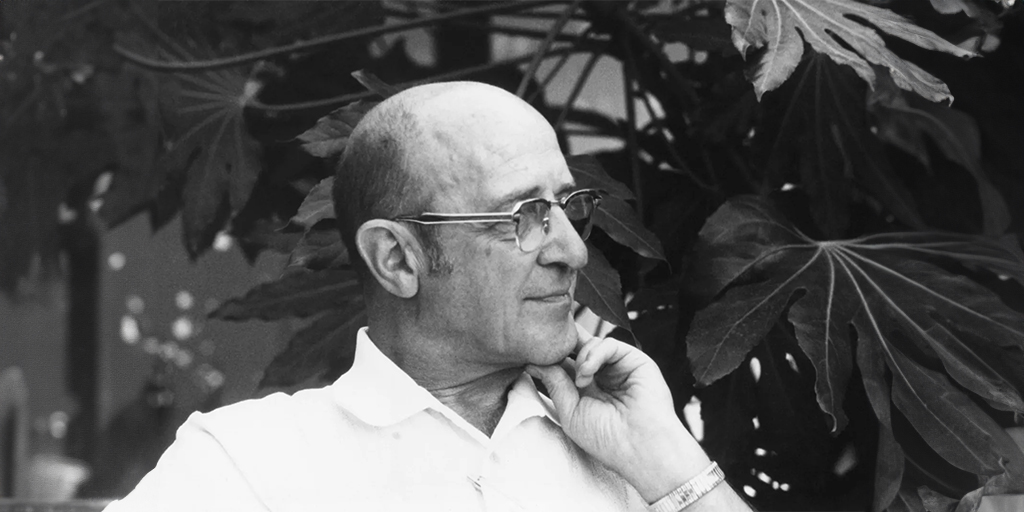How Carl Rogers Reinvented the Therapeutic Relationship

Change is possible. You can make it happen. These concepts are foundational to evidence-based practices that support behavior change. The transtheoretical model of behavior change, motivational interviewing and Interactive Journaling® are a few well-known methods that apply this philosophy. And these proven approaches owe significant credit to Carl Rogers, the father of person-centered therapy.
Carl Rogers (1902-1987) was an American psychologist and a founder of the humanistic, or person-centered, approach. One of the world’s most influential psychologists, Rogers was the first therapist to record his own counseling sessions and research his results. He is known for books including “The Clinical Treatment of the Problem Child,” “Client-Centered Therapy” and “On Becoming a Person.”
Throughout his career, Rogers argued that every person is capable of growth and change. Under his view, clients don’t need to be fixed by a professional who offers advice, judgment and direction – they have plenty of inner resources to make positive change. Therefore, a genuine, empathic and accepting environment can equip people to transform their own lives.
Here are some of Rogers’ key contributions to person-centered therapy:
The Therapeutic Relationship and Patient-Centered Therapy
Rogers thoroughly disrupted the existing one-up relationship model for patient and therapist. He was the first practitioner to popularize the term “client” instead of “patient,” based on the idea that therapists are equal collaborators rather than elevated experts. Rogers later chose the term “person,” which he believed to be an even more helpful alternative.
In Rogers’ view, people are experts on themselves. They hold the power for making change. Therefore, therapists need their clients’ personal expertise as much as any professional knowledge. To facilitate change, conversations are collaborative, exploring the changes clients would like to make and how they would go about it.
Unconditional Positive Regard
How can you create a safe environment for clients to honestly express their thoughts, feelings, actions and experiences? According to Rogers, a successful relationship requires unconditional positive regard. Therapists show this by consistently expressing warmth, letting clients know they are valued and offering support without judgment.
Unconditional positive regard means clients don’t need to prove they deserve your respect. They have inherent worth, Rogers argued, and the relationship will be more productive when they are accepted where they are.
The Fully Functioning Person
What is your ideal self like? Does your vision match the person you believe you are today? This is Rogers’ idea of “congruence” – every person’s desired state of consistency between who they want to be and who they are. Rogers suggested that receiving unconditional positive regard and pursuing growth helps a person move toward greater congruence.
Rogers believed every person possesses a deep need to grow toward their potential, and that self-actualization is at the core of motivation and behavior. Accordingly, people who strive to fulfill their potential become more congruent, present and flexible. With unconditional self-regard, they are open to experience and able to live in harmony with others. This is Rogers’ vision of a fully functioning person.
Accurate Empathy
One of the most powerful tools for effective therapy is accurate empathy – research shows it can enable positive change more than any other skill. It’s important to note that Rogers’ definition of empathy does not suggest a therapist must share the same experiences or feelings as clients. Rather, it is a learnable, clinical skill.
Rogers’ idea of empathy means entering the perceived world of another person, listening with sensitivity and showing no fear or judgment toward what they express. The goal is to understand their perspective on a deep level. In Rogers’ approach, this is accomplished through reflective listening.
To achieve understanding, a reflective listener offers gentle guesses about what the speaker means. Rather than ask questions, like “Do you mean that you…?”, this is done by making statements. Consider the difference between the following responses:
You really don’t see any problem with what you’re doing.
You really don’t see any problem with what you’re doing?
A question can evoke defensiveness if it makes the person feel pressured, threatened or challenged. On the other hand, you can continue refining your statements based on immediate feedback as to whether they are correct or incorrect. In this way, reflective listening helps both therapist and client move toward a clearer understanding.
Early in his career, Rogers was distressed by misrepresentations of his “nondirective” approach. Some contemporaries reduced his vision of accurate empathy to a pattern of simply repeating the last few words spoken by the client. In contrast, Rogers advocated for a thoughtful practice allowing therapists to reach a more meaningful, nuanced understanding of their clients’ perspectives.
Evocation
Another key influence of Rogers’ work was his emphasis on evocation, which has been expanded in methods like motivational interviewing. Rogers strongly believed in each person’s autonomy, reminding therapists not to tell clients what they can and can’t do. Instead, he suggested practitioners honor the fact that people get to make their own life choices.
“The good life is a process, not a state of being. It is a direction, not a destination.” — Carl Rogers
According to Rogers, every person wants to be healthy and well on some level. They have an innate tendency to move in the right direction with nurturing and acceptance. Rather than viewing a person’s issues as problems you need to correct, evocation calls forth the person’s own motivations, wisdom and abilities. The implicit message is, “You have what you need, and together we are going to find it.”
Interactive Journals: Contributing to Person-centered Therapy Treatment and Self-directed Change
It is vital for people to be actively engaged in their own treatment. Building on the work of Drs. Carl Rogers, William R. Miller, James Prochaska and others, The Change Companies® publishes Interactive Journals to guide and motivate individuals toward positive behavior change. These person-centered Journals emphasize self-efficacy and help individuals identify their own meaningful reasons to change.
Interactive Journals support the therapeutic alliance by providing structured questions that get to the heart of individuals’ thoughts, beliefs and behaviors. You can select single Journals or flexible series that specifically match client objectives. Interactive Journals are compatible with the ASAM dimensions and have underpinnings in motivational interviewing, cognitive-behavioral therapy, expressive writing and the transtheoretical model of behavior change.
If you’d like help identifying the best Journals for your program, contact us at 888-889-8866. Team members at The Change Companies® can make informed recommendations and provide implementation training for your staff.

